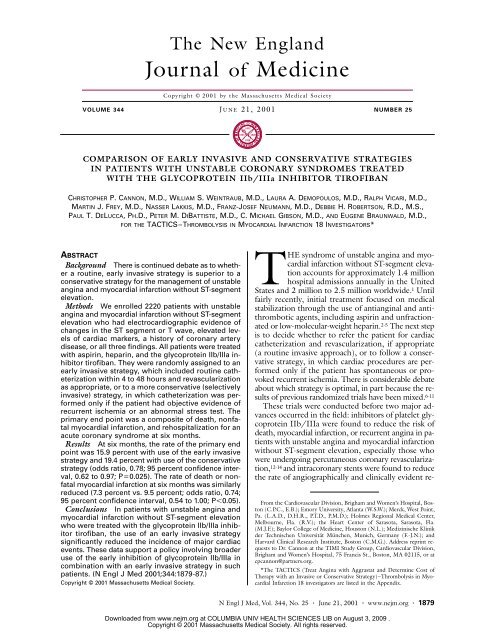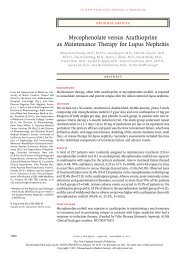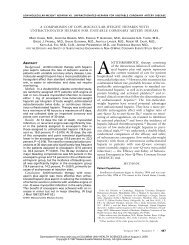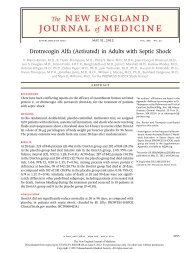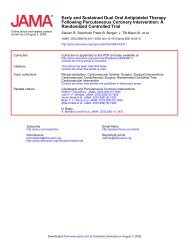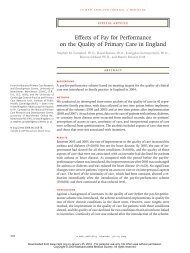N Engl J Med 2001 - Columbiamedicine2.org
N Engl J Med 2001 - Columbiamedicine2.org
N Engl J Med 2001 - Columbiamedicine2.org
Create successful ePaper yourself
Turn your PDF publications into a flip-book with our unique Google optimized e-Paper software.
The New <strong>Engl</strong>and<br />
Journal of <strong>Med</strong>icine<br />
Copyright © <strong>2001</strong> by the Massachusetts <strong>Med</strong>ical Society<br />
VOLUME 344 J UNE 21, <strong>2001</strong> NUMBER 25<br />
COMPARISON OF EARLY INVASIVE AND CONSERVATIVE STRATEGIES<br />
IN PATIENTS WITH UNSTABLE CORONARY SYNDROMES TREATED<br />
WITH THE GLYCOPROTEIN IIb/IIIa INHIBITOR TIROFIBAN<br />
CHRISTOPHER P. CANNON, M.D., WILLIAM S. WEINTRAUB, M.D., LAURA A. DEMOPOULOS, M.D., RALPH VICARI, M.D.,<br />
MARTIN J. FREY, M.D., NASSER LAKKIS, M.D., FRANZ-JOSEF NEUMANN, M.D., DEBBIE H. ROBERTSON, R.D., M.S.,<br />
PAUL T. DELUCCA, PH.D., PETER M. DIBATTISTE, M.D., C. MICHAEL GIBSON, M.D., AND EUGENE BRAUNWALD, M.D.,<br />
FOR THE TACTICS–THROMBOLYSIS IN MYOCARDIAL INFARCTION 18 INVESTIGATORS*<br />
ABSTRACT<br />
Background There is continued debate as to whether<br />
a routine, early invasive strategy is superior to a<br />
conservative strategy for the management of unstable<br />
angina and myocardial infarction without ST-segment<br />
elevation.<br />
Methods We enrolled 2220 patients with unstable<br />
angina and myocardial infarction without ST-segment<br />
elevation who had electrocardiographic evidence of<br />
changes in the ST segment or T wave, elevated levels<br />
of cardiac markers, a history of coronary artery<br />
disease, or all three findings. All patients were treated<br />
with aspirin, heparin, and the glycoprotein IIb/IIIa inhibitor<br />
tirofiban. They were randomly assigned to an<br />
early invasive strategy, which included routine catheterization<br />
within 4 to 48 hours and revascularization<br />
as appropriate, or to a more conservative (selectively<br />
invasive) strategy, in which catheterization was performed<br />
only if the patient had objective evidence of<br />
recurrent ischemia or an abnormal stress test. The<br />
primary end point was a composite of death, nonfatal<br />
myocardial infarction, and rehospitalization for an<br />
acute coronary syndrome at six months.<br />
Results At six months, the rate of the primary end<br />
point was 15.9 percent with use of the early invasive<br />
strategy and 19.4 percent with use of the conservative<br />
strategy (odds ratio, 0.78; 95 percent confidence interval,<br />
0.62 to 0.97; P=0.025). The rate of death or nonfatal<br />
myocardial infarction at six months was similarly<br />
reduced (7.3 percent vs. 9.5 percent; odds ratio, 0.74;<br />
95 percent confidence interval, 0.54 to 1.00; P
The New <strong>Engl</strong>and Journal of <strong>Med</strong>icine<br />
stenosis. 15,16 Given these advances, we hypothesized<br />
that an early invasive strategy would be superior to a<br />
more conservative approach.<br />
METHODS<br />
Study Population<br />
Between December 18, 1997, and December 22, 1999, a total<br />
of 2220 patients underwent randomization. The protocol was approved<br />
by the relevant institutional review boards, and written informed<br />
consent was obtained from all patients. The study design has<br />
been described previously. 17 Briefly, men and women who were at<br />
least 18 years old were eligible for inclusion if they had had an episode<br />
of angina (with an accelerating pattern or prolonged [>20<br />
minutes] or recurrent episodes at rest or with minimal effort) within<br />
the preceding 24 hours, were candidates for coronary revascularization,<br />
and had at least one of the following: a new finding of<br />
ST-segment depression of at least 0.05 mV, transient (0.01 ng per milliliter) in 54<br />
percent of the 1826 patients in whom they were measured,<br />
whereas 27 percent had evidence of prior coronary<br />
artery disease as the sole criterion for enrollment.<br />
1880 · N <strong>Engl</strong> J <strong>Med</strong>, Vol. 344, No. 25 · June 21, <strong>2001</strong> · www.nejm.org<br />
Downloaded from www.nejm.org at COLUMBIA UNIV HEALTH SCIENCES LIB on August 3, 2009 .<br />
Copyright © <strong>2001</strong> Massachusetts <strong>Med</strong>ical Society. All rights reserved.
EARLY INVASIVE AND CONSERVATIVE STRATEGIES IN PATIENTS WITH UNSTABLE CORONARY SYNDROMES<br />
TABLE 1. BASE-LINE CHARACTERISTICS OF THE PATIENTS.*<br />
CHARACTERISTIC<br />
INVASIVE<br />
STRATEGY<br />
(N=1114)<br />
CONSERVATIVE<br />
STRATEGY<br />
(N=1106)<br />
Age — yr 62±11.4 62±11.9<br />
Age »65 yr — no. (%) 491 (44) 471 (43)<br />
Female sex — no. (%) 395 (35) 362 (33)<br />
White race — no. (%) 856 (77) 866 (78)<br />
Prior myocardial infarction — no. (%) 437 (39) 429 (39)<br />
Prior aspirin use — no. (%) 752 (68) 725 (66)<br />
Diabetes — no. (%) 313 (28) 300 (27)<br />
ST-segment changes — no. (%) 434 (39) 418 (38)<br />
ST-segment or T-wave changes — no. (%) 531 (48) 524 (47)<br />
Myocardial infarction without ST-segment 417 (37) 409 (37)<br />
elevation — no. (%)<br />
Troponin T — ng/ml† 0.38±0.94 0.33±0.71<br />
Troponin T >0.01 ng/ml — no. (%)† 506 (56) 480 (52)<br />
*Plus–minus values are means ±SD. None of the differences between<br />
groups were statistically significant.<br />
†Troponin T was measured at base line in 920 patients in the invasivestrategy<br />
group and 906 patients in the conservative-strategy group.<br />
Base-line angiographic data in the group assigned to<br />
the early invasive strategy revealed stenosis of the left<br />
main coronary artery in 9 percent, three-vessel disease<br />
in 34 percent, and normal vessels in 13 percent.<br />
In the invasive-strategy group, 97 percent of the<br />
patients underwent cardiac catheterization during the<br />
initial hospitalization a median of 22 hours after randomization,<br />
and 60 percent underwent percutaneous<br />
coronary revascularization or coronary-artery bypass<br />
grafting a median of 25 and 89 hours, respectively,<br />
after randomization (Table 2). In the conservativestrategy<br />
group, 478 patients (43 percent) met the protocol<br />
criteria for failure of medical therapy during the<br />
initial hospitalization: 56 percent of these patients had<br />
an abnormal stress test, 37 percent had recurrent angina<br />
at rest with electrocardiographic changes, 4 percent<br />
had hemodynamic instability, and 4 percent had<br />
recurrent myocardial infarction. In an additional 8 percent,<br />
medical therapy failed during follow-up, and the<br />
patients were rehospitalized for unstable angina or myocardial<br />
infarction.<br />
Of the patients who were randomly assigned to<br />
the conservative strategy, 51 percent underwent catheterization<br />
and 36 percent underwent revascularization<br />
during the initial hospitalization. By six months<br />
the total rates of revascularization had increased by<br />
1 percentage point in the invasive-strategy group and<br />
by 8 percentage points in the conservative-strategy<br />
group. During the initial hospitalization, coronary<br />
stents were used in 83 percent of the percutaneous<br />
coronary revascularization procedures in the invasivestrategy<br />
group and in 86 percent of such procedures<br />
in the conservative-strategy group. Despite being available<br />
for all percutaneous coronary revascularization<br />
procedures conducted in both strategies, tirofiban was<br />
used during 94 percent of procedures in the invasivestrategy<br />
group and 59 percent of procedures in the<br />
conservative-strategy group. The median duration of<br />
tirofiban administration was 48 and 50 hours, respectively.<br />
TABLE 2. CARDIAC PROCEDURES CONDUCTED DURING THE INITIAL HOSPITALIZATION<br />
AND DURING THE FIRST SIX MONTHS.<br />
PROCEDURE INITIAL HOSPITALIZATION FIRST 6 MONTHS<br />
INVASIVE<br />
STRATEGY<br />
(N=1114)<br />
CONSERVATIVE<br />
STRATEGY<br />
(N=1106)<br />
INVASIVE<br />
STRATEGY<br />
(N=1114)<br />
CONSERVATIVE<br />
STRATEGY<br />
(N=1106)<br />
Catheterization<br />
No. of patients (%) 1085 (97) 561 (51) 1087 (98) 672 (61)<br />
Hours after randomization<br />
<strong>Med</strong>ian<br />
25th and 75th percentiles<br />
22<br />
18, 39<br />
79<br />
50, 137<br />
Percutaneous coronary revascularization<br />
No. of patients (%) 459 (41) 262 (24) 472 (42) 323 (29)<br />
Hours after randomization<br />
<strong>Med</strong>ian<br />
25th and 75th percentiles<br />
25<br />
19, 46<br />
93<br />
55, 167<br />
Coronary-artery bypass grafting<br />
No. of patients (%) 220 (20) 142 (13) 243 (22) 178 (16)<br />
Hours after randomization<br />
<strong>Med</strong>ian<br />
25th and 75th percentiles<br />
89<br />
48, 142<br />
144<br />
94, 305<br />
N <strong>Engl</strong> J <strong>Med</strong>, Vol. 344, No. 25 · June 21, <strong>2001</strong> · www.nejm.org · 1881<br />
Downloaded from www.nejm.org at COLUMBIA UNIV HEALTH SCIENCES LIB on August 3, 2009 .<br />
Copyright © <strong>2001</strong> Massachusetts <strong>Med</strong>ical Society. All rights reserved.
The New <strong>Engl</strong>and Journal of <strong>Med</strong>icine<br />
Primary End Point<br />
The rate of primary end point — death, nonfatal<br />
myocardial infarction, or rehospitalization for an acute<br />
coronary syndrome at six months — was 15.9 percent<br />
with use of the early invasive strategy and 19.4 percent<br />
with use of the conservative strategy (odds ratio,<br />
0.78; 95 percent confidence interval, 0.62 to 0.97;<br />
P=0.025) (Fig. 1 and Table 3). The results of the unadjusted<br />
analysis were almost identical: the odds ratio<br />
was 0.78 (95 percent confidence interval, 0.63 to 0.98;<br />
P=0.028). This reduction was seen after the first week<br />
(Fig. 1) and at 30 days (P=0.009) (Table 3). Similarly,<br />
the likelihood of death or nonfatal myocardial infarction<br />
was significantly lower in the invasive-strategy<br />
group than in the conservative-strategy group at 30<br />
days (4.7 percent vs. 7.0 percent; odds ratio, 0.65; 95<br />
percent confidence interval, 0.45 to 0.93; P=0.02)<br />
and at 6 months (7.3 percent vs. 9.5 percent; odds<br />
ratio, 0.74; 95 percent confidence interval, 0.54 to<br />
1.00; P
EARLY INVASIVE AND CONSERVATIVE STRATEGIES IN PATIENTS WITH UNSTABLE CORONARY SYNDROMES<br />
TABLE 3. CLINICAL OUTCOMES ASSOCIATED WITH THE INVASIVE STRATEGY,<br />
AS COMPARED WITH THE CONSERVATIVE STRATEGY.*<br />
OUTCOME<br />
INVASIVE<br />
STRATEGY<br />
(N=1114)<br />
CONSERVATIVE<br />
STRATEGY<br />
(N=1106)<br />
ODDS RATIO<br />
(95% CI) P VALUE<br />
*CI denotes confidence interval.<br />
no. (%)<br />
At 30 days<br />
Primary end point 82 (7.4) 116 (10.5) 0.67 (0.50–0.91) 0.009<br />
Death or nonfatal myocardial 52 (4.7) 77 (7.0) 0.65 (0.45–0.93) 0.02<br />
infarction<br />
Death 25 (2.2) 18 (1.6) 1.40 (0.76–2.59) 0.29<br />
Fatal or nonfatal myocardial 34 (3.1) 64 (5.8) 0.51 (0.33–0.77) 0.002<br />
infarction<br />
Rehospitalization for acute 38 (3.4) 61 (5.5) 0.61 (0.40–0.92) 0.018<br />
coronary syndrome<br />
At 6 months<br />
Primary end point 177 (15.9) 215 (19.4) 0.78 (0.62–0.97) 0.025<br />
Death or nonfatal myocardial 81 (7.3) 105 (9.5) 0.74 (0.54–1.00)
The New <strong>Engl</strong>and Journal of <strong>Med</strong>icine<br />
BASE-LINE VARIABLE NO. (%) ODDS RATIO<br />
PRIMARY END POINT<br />
0.0 0.5 1.0 1.5 2.0<br />
INVASIVE<br />
STRATEGY<br />
%<br />
CONSERVATIVEŁ<br />
STRATEGY<br />
Age 5 ng/ml<br />
Creatine kinase MB «5 ng/ml<br />
<br />
Troponin T >0.1 ng/ml<br />
Troponin T «0.1 ng/ml<br />
<br />
TIMI risk scoreŁ<br />
0–2 (low)Ł<br />
3–4 (intermediate)<br />
5–7 (high)<br />
1258 (57)<br />
962 (43)<br />
<br />
1463 (66)<br />
757 (34)<br />
<br />
866 (39)<br />
1354 (61)<br />
<br />
1477 (66)<br />
743 (34)<br />
<br />
613 (28)<br />
1607 (72)<br />
<br />
852 (38)<br />
1368 (62)<br />
<br />
833 (39)<br />
1297 (61)<br />
<br />
748 (41)<br />
1078 (59)<br />
<br />
Ł<br />
555 (25)<br />
1328 (60)<br />
337 (15)<br />
14.9<br />
17.1<br />
<br />
15.3<br />
17.0<br />
<br />
18.8<br />
14.0<br />
<br />
17.7<br />
12.2<br />
<br />
20.1<br />
14.2<br />
<br />
16.4<br />
15.6<br />
<br />
17.3<br />
15.4<br />
<br />
16.4<br />
15.1<br />
<br />
Ł<br />
12.8<br />
16.1<br />
19.5<br />
17.8<br />
21.7<br />
<br />
19.4<br />
19.6<br />
<br />
24.2<br />
16.4<br />
<br />
18.6<br />
21.0<br />
<br />
27.7<br />
16.4<br />
<br />
26.3<br />
15.3<br />
<br />
23.9<br />
16.8<br />
<br />
24.5<br />
16.6<br />
<br />
Ł<br />
11.8<br />
20.3<br />
30.6<br />
Invasive<br />
Strategy Better<br />
Conservative<br />
Strategy Better<br />
Figure 2. Rates of the Primary End Point of Death, Nonfatal Myocardial Infarction, or Rehospitalization for an Acute Coronary Syndrome<br />
at Six Months, According to Base-Line Characteristics.<br />
Odds ratios and 95 percent confidence intervals were determined by logistic-regression analysis. P values for the interaction were<br />
significant only for prior aspirin use (P=0.02) and ST-segment changes (P=0.006). For the analysis of the TIMI risk score, which<br />
assesses the risk of death and ischemic events in patients with unstable angina and myocardial infarction without ST-segment elevation,<br />
the upper bound of the confidence interval for a score of 3 to 4 was 0.999 (P=0.048; P for the interaction among the three<br />
risk groups=0.15). Troponin T was measured at base line in a total of 1826 patients. MI denotes myocardial infarction.<br />
graphic imaging in nearly all patients and an electrocardiographic<br />
criterion of the presence of ST-segment<br />
depression of at least 0.1 mV for an abnormal test,<br />
which is consistent with the 1994 and 2000 guidelines<br />
for the management of unstable angina and myocardial<br />
infarction without ST-segment elevation. 1,24 This approach<br />
led to cardiac catheterization in approximately<br />
50 percent of patients.<br />
The conservative strategy in the Fragmin and Fast<br />
Revascularization during Instability in Coronary Artery<br />
Disease (FRISC) II trial used more stringent criteria<br />
for ischemia, in which an abnormal stress test and<br />
electrocardiographic evidence of ST-segment depression<br />
of at least 0.3 mV were required for a patient to<br />
undergo cardiac catheterization. 10 Consequently, only<br />
10 percent of patients underwent cardiac catheterization<br />
during the initial hospitalization. The study reported<br />
that, as compared with this very conservative<br />
strategy, the invasive strategy was associated with a<br />
lower rate of death or myocardial infarction and a lower<br />
one-year mortality rate. 10<br />
Thus, because the conservative strategy they used 10<br />
was more conservative than the strategies recommended<br />
in both the 1994 and 2000 guidelines for the treatment<br />
of unstable angina and myocardial infarction<br />
without ST-segment elevation, 1,24 it was important<br />
to determine the outcomes of a more selective invasive<br />
strategy. In addition, the antithrombotic therapy<br />
used in FRISC II — dalteparin — has not been shown<br />
to be more efficacious than unfractionated heparin. In<br />
our study, we used both improved antithrombotic<br />
therapy and more sensitive monitoring for ischemia,<br />
an approach that would also improve the outcomes<br />
of the conservative strategy. In spite of this improved<br />
conservative strategy, we found that the early invasive<br />
strategy, which included early inhibition of glycoprotein<br />
IIb/IIIa and stenting, was superior in reducing<br />
the incidence of major cardiac events.<br />
1884 · N <strong>Engl</strong> J <strong>Med</strong>, Vol. 344, No. 25 · June 21, <strong>2001</strong> · www.nejm.org<br />
Downloaded from www.nejm.org at COLUMBIA UNIV HEALTH SCIENCES LIB on August 3, 2009 .<br />
Copyright © <strong>2001</strong> Massachusetts <strong>Med</strong>ical Society. All rights reserved.
EARLY INVASIVE AND CONSERVATIVE STRATEGIES IN PATIENTS WITH UNSTABLE CORONARY SYNDROMES<br />
TABLE 4. OUTCOMES ASSOCIATED WITH THE INVASIVE STRATEGY AS COMPARED<br />
WITH THE CONSERVATIVE STRATEGY, ACCORDING TO THE BASE-LINE LEVEL<br />
OF TROPONIN T.*<br />
OUTCOME<br />
INVASIVE<br />
STRATEGY<br />
CONSERVATIVE<br />
STRATEGY<br />
ODDS RATIO<br />
(95% CI) P VALUE<br />
no. (%)<br />
At 30 days<br />
Troponin T >0.01 ng/ml<br />
No. of patients<br />
Primary end point<br />
Death or nonfatal myocardial<br />
infarction<br />
Troponin T «0.01 ng/ml<br />
No. of patients<br />
Primary end point<br />
Death or nonfatal myocardial<br />
infarction<br />
506<br />
40 (7.9)<br />
27 (5.3)<br />
414<br />
25 (6.0)<br />
12 (2.9)<br />
480<br />
78 (16.2)<br />
51 (10.6)<br />
426<br />
24 (5.6)<br />
13 (3.1)<br />
0.44 (0.30–0.66)<br />
0.47 (0.29–0.77)<br />
1.08 (0.60–1.92)<br />
0.95 (0.43–2.10)<br />
0.01 ng/ml<br />
No. of patients<br />
Primary end point<br />
Death or nonfatal myocardial<br />
infarction<br />
Troponin T «0.01 ng/ml<br />
No. of patients<br />
Primary end point<br />
Death or nonfatal myocardial<br />
infarction<br />
506<br />
75 (14.8)<br />
45 (8.9)<br />
414<br />
69 (16.7)<br />
18 (4.3)<br />
480<br />
116 (24.2)<br />
59 (12.3)<br />
426<br />
63 (14.8)<br />
22 (5.2)<br />
0.55 (0.40–0.75)<br />
0.70 (0.46–1.05)<br />
1.15 (0.79–1.67)<br />
0.83 (0.44–1.58)<br />
The New <strong>Engl</strong>and Journal of <strong>Med</strong>icine<br />
We used immediate inhibition of glycoprotein IIb/<br />
IIIa as part of the medical treatment of all patients.<br />
Early treatment with tirofiban, heparin, and aspirin<br />
has been shown to reduce the incidence of coronary<br />
thrombus, 25 improve blood flow (TIMI flow grade<br />
3), 25 and lead to a reduction (by 66 percent) in the<br />
rate of death or myocardial infarction within 48 hours<br />
as compared with treatment with aspirin and heparin<br />
alone. 12,26 Furthermore, the size of evolving myocardial<br />
infarctions without ST-segment elevation was reduced<br />
with tirofiban (as measured on the basis of<br />
troponin I levels) 27 ; this finding was confirmed in another<br />
trial that used a different glycoprotein IIb/IIIa<br />
inhibitor and measured creatine kinase MB levels. 28,29<br />
Finally, the reduction in the rate of death or myocardial<br />
infarction 30 days after treatment with tirofiban,<br />
heparin, and aspirin, as compared with heparin and<br />
aspirin alone, was consistent among patients treated<br />
medically, with percutaneous coronary revascularization,<br />
and with coronary-artery bypass grafting. 12,14,30,31<br />
To provide patients with all these benefits, we administered<br />
tirofiban immediately after randomization.<br />
The rate of death or nonfatal myocardial infarction at<br />
30 days in the invasive-strategy group was just 4.7 percent,<br />
which compares favorably to the rates in prior<br />
studies of patients with unstable angina and myocardial<br />
infarction without ST-segment elevation. 22 Whether<br />
similar results could be achieved in this population<br />
if treatment with a glycoprotein IIb/IIIa inhibitor<br />
was initiated in the catheterization laboratory only in<br />
patients undergoing percutaneous coronary revascularization<br />
should be tested in a prospective trial. For<br />
patients in the invasive-strategy group who underwent<br />
percutaneous coronary revascularization after having<br />
received tirofiban, the rate of death or myocardial infarction<br />
at 30 days was 5.3 percent (Table 5), which<br />
also compares favorably with the results of other recent<br />
trials of percutaneous coronary revascularization<br />
with other inhibitors of glycoprotein IIb/IIIa.<br />
The value of cardiac troponin levels as a means of<br />
identifying high-risk patients has been well documented.<br />
32-34 Furthermore, elevations in troponin T and I<br />
levels have been found to identify the patients who<br />
will benefit from more intensive antithrombotic therapy,<br />
which includes low-molecular-weight heparin and<br />
inhibition of glycoprotein IIb/IIIa. 35-38 A major objective<br />
of our study was to test prospectively the validity<br />
of the troponin hypothesis — that the measurement<br />
of troponin T or I at the time of presentation is<br />
useful in determining the optimal treatment strategy.<br />
We observed that patients with elevated levels of troponin<br />
T at base line derived a greater benefit from the<br />
early invasive strategy than did those without elevated<br />
levels. Thus, the use of this marker could be incorporated<br />
into management approaches for the triage of patients<br />
with respect to an early invasive strategy.<br />
We found that for patients with unstable angina and<br />
myocardial infarction without ST-segment elevation,<br />
an early invasive strategy is superior to a conservative<br />
or a selectively invasive strategy in reducing the incidence<br />
of major cardiac events. This benefit applied to<br />
most patients studied, especially those at intermediate<br />
or high risk, whereas the low-risk patients had similar<br />
outcomes with the use of either strategy, indicating<br />
the usefulness of early risk stratification. Our results<br />
provide evidence to physicians of the value of broader<br />
use of a strategy of early inhibition of glycoprotein<br />
IIb/IIIa in combination with an early invasive approach.<br />
Supported by Merck.<br />
Drs. Demopoulos, DiBattiste, and DeLucca and Ms. Robertson are employees<br />
of Merck.<br />
APPENDIX<br />
The following investigators and research coordinators participated in the<br />
study (the complete list of investigators and coordinators is available at<br />
http://www.timi.org): Steering Committee — C. Cannon (chairman), E.<br />
Braunwald (TIMI study chairman), J. Adgey, S. Ellis, M. Gibson, T. Henry,<br />
S. King, N. Kleiman, R. Piana, J. Popma, P. Teirstein, W. Weintraub; Economics<br />
Committee — W. Weintraub (chairman), S. Ellis, D. Feeny, H.<br />
Krumholtz, D. Cohen, J. Spertus, S. Culler, A. Kosinski, E. Mahoney, C.<br />
Jurkovitz; Clinical Events Committee — S. Borzak (chairman), M. Attabuto,<br />
N. Bernstein, H. Cooper, R. Giugliano, A. Jacobs, G. Koren, P. Mc-<br />
Cullough, T. Palabrica, C. Rogers, G. Tofler; TIMI Study Office — C.H.<br />
McCabe (project director), S. McHale; TIMI Angiographic Core Laboratory<br />
(Harvard Clinical Research Institute, Boston) — M. Gibson, S. Marble, S.<br />
Murphy; TIMI Serum Marker Core Laboratory (Children’s Hospital, Boston)<br />
— N. Rifai, J. Matsubara, J. Barrow; Data and Safety Monitoring<br />
Board — W. Parmley (chairman), E. Alderman, H. Anderson, S. Kelsey;<br />
Data Coordinating Center (Quintiles, Research Triangle Park, N.C.) — D.<br />
Mackey, C. Kelly, D. Schneider, C. Tate, J. Nelson, D. Sen, J. Davis; Merck<br />
— L. Demopoulos, P. DiBattiste, F. Sax, G. Tarnesby, T. Bunt, D. Robertson,<br />
P. Dellea, A. Brinton, C. Polamalu, P. DeLucca; the 25 clinical centers<br />
enrolling the most patients (in order of enrollment) — Holmes Regional<br />
<strong>Med</strong>ical Center, Melbourne, Fla.: R. Vicari, K. Koteek; Heart Center of<br />
Sarasota and Doctor’s Hospital of Sarasota, Sarasota, Fla.: M. Frey, N.<br />
Fichter, T. McMullen; Ben Taub General Hospital, Houston: N. Lakkis, S.<br />
Runchey; Heart Center Research Division, Huntsville, Ala.: R. Hunter, N.<br />
Keenum, C. Cholewa; North Mississippi <strong>Med</strong>ical Center, Tupelo: B. Bertolet,<br />
C. Bond; German Heart Center, Munich, Germany: F. Neumann, G.<br />
Pogatsa-Murray; East Carolina School of <strong>Med</strong>icine, Greenville, N.C.: J.<br />
Babb, D. Bembridge; University of Oklahoma, Oklahoma City: A. Kugelmass,<br />
J. Wells; United Hospital, St. John’s Hospital, and St. Joseph’s Hospital,<br />
St. Paul, Minn.: K. Baran, C. Iacarella; Fundacion Cardio-Infantil<br />
Santafe de Bogotá, Bogota, Colombia: M. Pineda, C. Ceballos; Cardiology<br />
of Oklahoma, Tulsa: M. Carney, P. Flaugh; Garden City Hospital, Garden<br />
City, Mich.: W. Back, L. Meharg, R. Morgan; Covenant <strong>Med</strong>ical Center,<br />
Saginaw, Mich.: P. Fattal, B. Garner; University of Regensburg, Regensburg,<br />
Germany: E. Kromer, P. Schunkert, K. Kurzidim; Louisiana State<br />
University <strong>Med</strong>ical Center, Shreveport: F. Sheridan, C. Stephens; Veterans<br />
Affairs <strong>Med</strong>ical Center, Albuquerque, N.M.: S. Vernon, J. Collatz; Centre<br />
Hospitalier des Vallees de l’Outaouais, Hull, Que., Canada: M. Nguyen, E.<br />
Phillipe; Suburban Cardiologists, Drexel Hill, Pa.: E. LaPorta, M. Coll;<br />
Vassar Brothers Hospital, Poughkeepsie, N.Y.: D. O’Dea, P. Soriano; San<br />
Diego Veterans Affairs <strong>Med</strong>ical Center, San Diego, Calif.: W. Penny, G.<br />
Poteat; University of Michigan <strong>Med</strong>ical Center, Ann Arbor: E. Bates, J.<br />
Fortino; <strong>Med</strong>ical Clinic I, University of Aachen, Aachen, Germany: P.<br />
Hanrath, K.-C. Koch; Montefiore <strong>Med</strong>ical Center, Bronx, N.Y.: H. Mueller,<br />
J. Kouns, J. Cosico; Grass Valley Cardiology, Grass Valley, Calif.: P. Callaham,<br />
R. Schnabel-Petersen; Harborview <strong>Med</strong>ical Center and University<br />
of Washington <strong>Med</strong>ical Center, Seattle: M. Corson, C. Brown, R. Divine;<br />
Akron General <strong>Med</strong>ical Center, Akron, Ohio: J. Hodsden, D. Hudock.<br />
REFERENCES<br />
1. Braunwald E, Antman EM, Beasley JW, et al. ACC/AHA guidelines for<br />
the management of patients with unstable angina and non-ST-segment elevation<br />
myocardial infarction: a report of the American College of Cardiology/American<br />
Heart Association Task Force on Practice Guidelines<br />
(Committee on the Management of Patients with Unstable Angina). J Am<br />
Coll Cardiol 2000;36:970-2.<br />
1886 · N <strong>Engl</strong> J <strong>Med</strong>, Vol. 344, No. 25 · June 21, <strong>2001</strong> · www.nejm.org<br />
Downloaded from www.nejm.org at COLUMBIA UNIV HEALTH SCIENCES LIB on August 3, 2009 .<br />
Copyright © <strong>2001</strong> Massachusetts <strong>Med</strong>ical Society. All rights reserved.
EARLY INVASIVE AND CONSERVATIVE STRATEGIES IN PATIENTS WITH UNSTABLE CORONARY SYNDROMES<br />
2. Théroux P, Ouimet H, McCans J, et al. Aspirin, heparin, or both to<br />
treat acute unstable angina. N <strong>Engl</strong> J <strong>Med</strong> 1988;319:1105-11.<br />
3. The RISC Group. Risk of myocardial infarction and death during treatment<br />
with low dose aspirin and intravenous heparin in men with unstable<br />
coronary artery disease. Lancet 1990;336:827-30.<br />
4. Oler A, Whooley MA, Oler J, Grady D. Adding heparin to aspirin reduces<br />
the incidence of myocardial infarction and death in patients with unstable<br />
angina: a meta-analysis. JAMA 1996;276:811-5.<br />
5. Antman EM, Cohen M, Radley D, et al. Assessment of the treatment<br />
effect of enoxaparin for unstable angina/non-Q-wave myocardial infarction:<br />
TIMI 11B-ESSENCE meta-analysis. Circulation 1999;100:1602-<br />
8.<br />
6. Effects of tissue plasminogen activator and a comparison of early invasive<br />
and conservative strategies in unstable angina and non-Q-wave myocardial<br />
infarction: results of the TIMI IIIB Trial. Circulation 1994;89:<br />
1545-56.<br />
7. Anderson HV, Cannon CP, Stone PH, et al. One-year results of the<br />
Thrombolysis in Myocardial Infarction (TIMI) IIIB clinical trial: a randomized<br />
comparison of tissue-type plasminogen activator versus placebo<br />
and early invasive versus early conservative strategies in unstable angina and<br />
non-Q-wave myocardial infarction. J Am Coll Cardiol 1995;26:1643-50.<br />
[Erratum, J Am Coll Cardiol 2000;35:263.]<br />
8. Boden WE, O’Rourke RA, Crawford MH, et al. Outcomes in patients<br />
with acute non–Q-wave myocardial infarction randomly assigned to an invasive<br />
as compared with a conservative management strategy. N <strong>Engl</strong> J<br />
<strong>Med</strong> 1998;338:1785-92. [Erratum, N <strong>Engl</strong> J <strong>Med</strong> 1998;339:1091.]<br />
9. McCullough PA, O’Neill WW, Graham M, et al. A prospective randomized<br />
trial of triage angiography in acute coronary syndromes ineligible for<br />
thrombolytic therapy: results of the <strong>Med</strong>icine versus Angiography in<br />
Thrombolytic Exclusion (MATE) trial. J Am Coll Cardiol 1998;32:596-<br />
605.<br />
10. FRagmin and Fast Revascularisation during InStability in Coronary artery<br />
disease (FRISC II) Investigators. Invasive compared with non-invasive<br />
treatment in unstable coronary-artery disease: FRISC II prospective randomised<br />
multicentre study. Lancet 1999;354:708-15.<br />
11. Wallentin L, Lagerqvist B, Husted S, Kontny F, Stahle E, Swahn E.<br />
Outcome at 1 year after an invasive compared with a non-invasive strategy<br />
in unstable coronary-artery disease: the FRISC II invasive randomised trial.<br />
Lancet 2000;356:9-16.<br />
12. The Platelet Receptor Inhibition in Ischemic Syndrome Management<br />
in Patients Limited by Unstable Signs and Symptoms (PRISM-PLUS)<br />
Study Investigators. Inhibition of the platelet glycoprotein IIb/IIIa receptor<br />
with tirofiban in unstable angina and non–Q-wave myocardial infarction.<br />
N <strong>Engl</strong> J <strong>Med</strong> 1998;338:1488-97. [Erratum, N <strong>Engl</strong> J <strong>Med</strong> 1998;<br />
339:415.]<br />
13. The Platelet Receptor Inhibition in Ischemic Syndrome Management<br />
(PRISM) Study Investigators. A comparison of aspirin plus tirofiban with<br />
aspirin plus heparin for unstable angina. N <strong>Engl</strong> J <strong>Med</strong> 1998;338:1498-<br />
505.<br />
14. The PURSUIT Trial Investigators. Inhibition of platelet glycoprotein<br />
IIb/IIIa with eptifibatide in patients with acute coronary syndromes.<br />
N <strong>Engl</strong> J <strong>Med</strong> 1998;339:436-43.<br />
15. Serruys PW, de Jaegere P, Kiemeneij F, et al. A comparison of balloonexpandable–stent<br />
implantation with balloon angioplasty in patients with<br />
coronary artery disease. N <strong>Engl</strong> J <strong>Med</strong> 1994;331:489-95.<br />
16. Fischman DL, Leon MB, Baim DS, et al. A randomized comparison<br />
of coronary-stent placement and balloon angioplasty in the treatment of<br />
coronary artery disease. N <strong>Engl</strong> J <strong>Med</strong> 1994;331:496-501.<br />
17. Cannon CP, Weintraub WS, Demopoulos LA, Robertson DH, Gormley<br />
GJ, Braunwald E. Invasive versus conservative strategies in unstable angina<br />
and non-Q-wave myocardial infarction following treatment with tirofiban:<br />
rationale and study design of the international TACTICS-TIMI 18<br />
Trial. Am J Cardiol 1998;82:731-6.<br />
18. Braunwald E. Unstable angina: a classification. Circulation 1989;80:<br />
410-4.<br />
19. Antman EM, Cohen M, Bernink PJ, et al. The TIMI risk score for unstable<br />
angina/non-ST elevation MI: a method for prognostication and<br />
therapeutic decision making. JAMA 2000;284:835-42.<br />
20. Cannon CP, McCabe CH, Wilcox RG, et al. Oral glycoprotein IIb/<br />
IIIa inhibition with orbofiban in patients with unstable coronary syndromes<br />
(OPUS-TIMI 16) trial. Circulation 2000;102:149-56.<br />
21. Antman EM, McCabe CH, Gurfinkel EP, et al. Enoxaparin prevents<br />
death and cardiac ischemic events in unstable angina/non-Q-wave myocardial<br />
infarction: results of the Thrombolysis in Myocardial Infarction<br />
(TIMI) 11B trial. Circulation 1999;100:1593-601.<br />
22. Kong DF, Califf RM, Miller DP, et al. Clinical outcomes of therapeutic<br />
agents that block the platelet glycoprotein IIb/IIIa integrin in ischemic<br />
heart disease. Circulation 1998;98:2829-35.<br />
23. Gunnar RM, Bourdillon PD, Dixon DW, et al. ACC/AHA guidelines<br />
for the early management of patients with acute myocardial infarction:<br />
a report of the American College of Cardiology/American Heart Association<br />
Task Force on Assessment of Diagnostic and Therapeutic Cardiovascular<br />
Procedures (Subcommittee to Develop Guidelines for the Early Management<br />
of Patients with Acute Myocardial Infarction). Circulation 1990;<br />
82:664-707.<br />
24. Braunwald E, Jones RH, Mark DB, et al. Diagnosing and managing<br />
unstable angina. Circulation 1994;90:613-22.<br />
25. Zhao X-Q, Theroux P, Snapinn SM, Sax FL. Intracoronary thrombus<br />
and platelet glycoprotein IIb/IIIa receptor blockade with tirofiban in unstable<br />
angina or non-Q-wave myocardial infarction: angiographic results<br />
from the PRISM-PLUS trial (Platelet Receptor Inhibition for Ischemic<br />
Syndrome Management in Patients Limited by Unstable Signs and Symptoms).<br />
Circulation 1999;100:1609-15.<br />
26. Boersma E, Akkerhuis KM, Theroux P, Califf RM, Topol EJ, Simoons<br />
ML. Platelet glycoprotein IIb/IIIa receptor inhibition in non-ST-elevation<br />
acute coronary syndromes: early benefit during medical treatment only,<br />
with additional protection during percutaneous coronary intervention. Circulation<br />
1999;100:2045-8.<br />
27. Januzzi JL, Hahn SS, Chae CU, et al. Effects of tirofiban plus heparin<br />
versus heparin alone on troponin I levels in patients with acute coronary<br />
syndromes. Am J Cardiol 2000;86:713-7.<br />
28. Alexander JH, Sparapani RA, Mahaffey KW, et al. Eptifibatide reduces<br />
the size and incidence of myocardial infarction in patients with non-STelevation<br />
acute coronary syndromes. J Am Coll Cardiol 1999;33:Suppl A:<br />
331A. abstract.<br />
29. Alexander JH, Sparapani RA, Mahaffey KW, et al. Association between<br />
minor elevations of creatine kinase-MB level and mortality in patients<br />
with acute coronary syndromes without ST-segment elevation.<br />
JAMA 2000;283:347-53.<br />
30. Barr E, Thornton AR, Sax FL, Snapinn SM, Theroux P. Benefit of tirofiban<br />
+ heparin therapy in unstable angina/non-Q-wave myocardial infarction<br />
patients is observed regardless of interventional treatment strategy.<br />
Circulation 1998;98:Suppl I:I-504. abstract.<br />
31. Lincoff AM, Harrington RA, Califf RM, et al. Management of patients<br />
with acute coronary syndromes in the United States by platelet glycoprotein<br />
IIb/IIIa inhibition: insights from the Platelet Glycoprotein IIb/<br />
IIIa in Unstable Angina: Receptor Suppression Using Integrilin Therapy<br />
(PURSUIT) trial. Circulation 2000;102:1093-100.<br />
32. Hamm CW, Ravkilde J, Gerhardt W, et al. The prognostic value of serum<br />
troponin T in unstable angina. N <strong>Engl</strong> J <strong>Med</strong> 1992;327:146-50.<br />
33. Antman EM, Tanasijevic MJ, Thompson B, et al. Cardiac-specific troponin<br />
I levels to predict the risk of mortality in patients with acute coronary<br />
syndromes. N <strong>Engl</strong> J <strong>Med</strong> 1996;335:1342-9.<br />
34. Ohman EM, Armstrong PW, Christenson RH, et al. Cardiac troponin<br />
T levels for risk stratification in acute myocardial ischemia. N <strong>Engl</strong> J <strong>Med</strong><br />
1996;335:1333-41.<br />
35. Lindhal B, Venge P, Wallentin L. Troponin T identifies patients with<br />
unstable coronary artery disease who benefit from long-term antithrombotic<br />
protection. J Am Coll Cardiol 1997;29:43-8.<br />
36. Morrow DA, Antman EM, Tanasijevic M, et al. Cardiac troponin I for<br />
stratification of early outcomes and the efficacy of enoxaparin in unstable<br />
angina: a TIMI-11B substudy. J Am Coll Cardiol 2000;36:1812-7.<br />
37. Hamm CW, Heeschen C, Goldmann B, et al. Benefit of abciximab in<br />
patients with refractory unstable angina in relation to serum troponin T<br />
levels. N <strong>Engl</strong> J <strong>Med</strong> 1999;340:1623-9. [Erratum, N <strong>Engl</strong> J <strong>Med</strong> 1999;<br />
341:548.]<br />
38. Heeschen C, Hamm CW, Goldmann B, Deu A, Langenbrink L,<br />
White HD. Troponin concentrations for stratification of patients with acute<br />
coronary syndromes in relation to therapeutic efficacy of tirofiban. Lancet<br />
1999;354:1757-62.<br />
Copyright © <strong>2001</strong> Massachusetts <strong>Med</strong>ical Society.<br />
N <strong>Engl</strong> J <strong>Med</strong>, Vol. 344, No. 25 · June 21, <strong>2001</strong> · www.nejm.org · 1887<br />
Downloaded from www.nejm.org at COLUMBIA UNIV HEALTH SCIENCES LIB on August 3, 2009 .<br />
Copyright © <strong>2001</strong> Massachusetts <strong>Med</strong>ical Society. All rights reserved.


